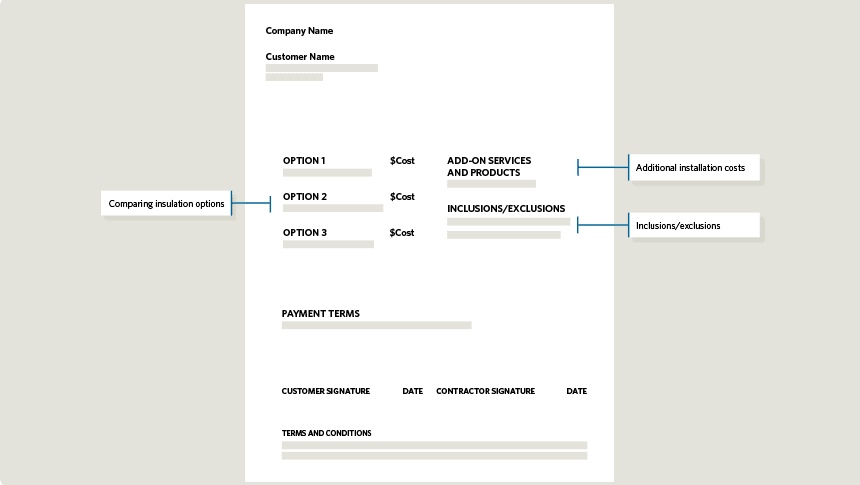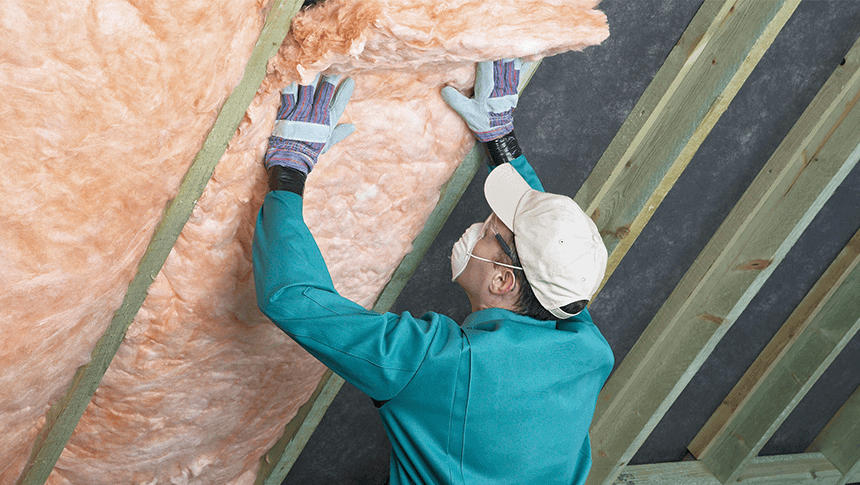When you’re ready to hire a contractor to install insulation in your home, it’s a good idea to seek bids from at least 3–4 different contractors. Reading and comparing bids for services can be a daunting task. Consider the following to help guide you through this process.

Inclusions/exclusions
Inclusions are what the contractor is committing to complete for the quoted amount. An exclusion typically describes work related to the primary services that the contractor is not agreeing to perform. This may include removing and disposing of existing insulation or debris, siding repair, insulating ducts or water pipes, etc. It’s important to ask your contractor if they believe you will need any of these services in order to complete the project.
While contractors may call out services or products not included, it’s also safe to assume that if it’s not mentioned it probably means it’s not included. It’s your responsibility to have the services you expect in writing before signing the bid. This includes expectations around site clean-up at the end of the day/project and potential rebate/incentive support. If you see something called out on Contractor A’s bid, but not included with Contractor B, this is a good opportunity to ask why.
Comparing insulation options
As you compare the different bids you receive, you may find it difficult to determine which solution is the best fit for your home. How do you decide between different insulation materials and installation methods? The following are some common options:
- Material choice: Fiberglass or cellulose? Spray foam? Rock wool? There are a variety of material options that can adequately insulate your home from the unwanted transfer of heat. Choosing the right material for your project can be tricky (and sometimes there really isn’t a wrong choice!). Ask your contractor to explain the benefits of the material they’re using in their bid and if there’s a reason to consider an alternative. For additional information, learn about materials and the benefits of insulating different areas of your home.
- Insulation location: You may be surprised to find your contractor is proposing multiple locations and ways to insulate a space. For example, you could insulate the attic floor or along the underside of the roof. A crawlspace could be insulated directly along the underside of the floor of the home, or you could choose to seal and insulate the perimeter walls. Consider how you plan to use the insulated space for the duration of your time in the home. Will the attic be used for frequently accessed storage? Or will it contain items that need to be in a temperature-controlled space? Do you plan to eventually convert the space into a bedroom or office? Are there moisture concerns? These are questions you should ask yourself and discuss with your contractor before choosing an insulation solution.
- Minimum amount of insulation: Deciding how much insulation you need can be confusing, especially if you’re receiving inconsistent guidance from the various contractors bidding your project. Unlike new construction homes, minimum insulation levels for existing homes are not regulated by Oregon or Washington energy codes. You can still use these guidelines as a reference, but you may find that it is difficult for your existing home to achieve the modern code levels due to limited access or space in your walls, attic or under the home. The minimum R-value for Energy Trust incentives is a good target if you’re looking for greater performance and energy efficiency. R-value is the metric used to rate a material’s insulating performance. The higher the R-value, the better the material is at resisting the transfer of heat.
- Maximum amount of insulation: Is it possible to have too much insulation? Yes. The insulation performance of some materials is negatively impacted when compressed, which can occur if too much material is jammed into a limited space. Additionally, the exit pathway of moisture/vapor may be inadvertently restricted if too much insulation is installed in an area where ventilation is required. Finally, you may find that going beyond the minimum levels proposed by either state energy codes or Energy Trust levels (see section above) results in a diminished return on your investment. Be sure to ask your contractor how they determined the level of insulation they’re recommending for your project.
Additional installation costs
Installation costs can vary significantly, both by contractor and across different conditions of the installation location. As referenced in the section above, be sure to thoroughly review the estimates provided by the contractors bidding on your project and compare what is and is not in the description of services. Additional factors that can impact your installation costs include:
- Air sealing: Insulation’s primary purpose is to resist the transfer of heat through conduction (think about your hand absorbing heat from a warm coffee mug). However, heat can also be transferred through the passage of air. It’s highly encouraged for us to have your contractor provide air sealing services when adding insulation. This is also a requirement to receive wall and floor insulation incentives from Energy Trust.
- Duct sealing and insulation: Ducts transferring heated and cooled air throughout the home are often located in attics and crawlspaces. If you’re having a contractor insulate these spaces, this is a great time to include duct sealing and insulation. Once an attic is insulated, you don’t want to have contractors traveling through the space, disrupting the newly installed insulation. If the ducts are located in a crawlspace, your new insulation will make this space much colder, and you’ll lose even more heat from poorly sealed and insulated ducts.
- Site preparation: Whether you’re adding insulation to exterior walls, an attic or crawlspace, it’s important to be sure the space is properly prepared by your contractor. This can include:
- Removing debris and/or damaged insulation.
- Adding and/or preventing obstruction of passive ventilation to ensure moisture has an opportunity to exit the space.
- Connecting bathroom or kitchen exhaust fans directly to the outside to avoid dumping moist air into the space.
- Building a dam to prevent loose fill insulation from spilling over to an area that doesn’t need insulation (attic).
- Insulating water supply pipes.
- Air sealing penetrations along the surfaces receiving insulation to prevent the transfer of heat through the passage of air.
- Protecting items not rated for contact with insulation, including but not limited to non-IC rated can lights, metal flues, exposed electrical connections, etc.
- Covering exposed dirt with a vapor barrier (crawlspace).
- Addressing potentially unsafe or hazardous conditions, including:
-
- Existing mold issues.
- Removing or avoiding disruption of material suspected of containing asbestos.
- Decommissioning knob-and-tube electrical wiring.
- Proper handling of lead paint.
- Mitigating water infiltration which includes leaky roofs, gutters/downspouts, and standing water in crawlspaces.
Don’t miss out on the resources available to you when upgrading your insulation. Energy Trust offers cash incentives and can help you find a contractor.
Insulation savings
Find incentives for your new insulation.
Insulation
Skill level: Medium
Heating and Cooling
Skill level: Easy
Insulation
Skill level: Medium



